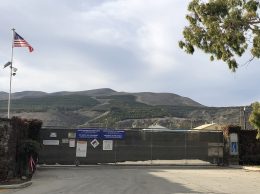Ventura demonstrates water treatment facility
IN THIS ARTICLE
- Latest news Topic
- Philip Joens Author
By Philip Joens Thursday, July 16th, 2015
The water was clear on July 16 at the Ventura Potable Water Reuse Demonstration Facility, though it wasn’t always clear.
The city of Ventura officially opened the demonstration facility Thursday morning on a tour for media and other selected guests. The facility takes treated waste water and treats it even more, which turns it into potable water.
Ventura plans to experiment with the small demonstration facility with the goal of using information learned there to potentially open a much larger treated waste water facility.
Craig Jones, environmental compliance inspector at Ventura Water, said right now the city essentially treats waste water to almost potable standards. That water is then used to irrigate crops, water golf courses or is discharged into the Santa Clara River Estuary.
“What this facility does is it takes highly treated water and makes it so it meets and or exceeds drinking water standards,” Jones said.
Gina Dorrington, Ventura Water’s waste water utility manager, said that’s done by taking treated waste water, pasteurizing it, sending it through three filters and finally treating it with an ultra-violet light.
“We’re flash pasteurizing the water, like you do with milk, and that will take care of a lot of the bacteria,” Dorrington said.
Andy Salveson, vice president and water reuse chief technologist at Carollo Engineers, said people are often afraid to drink treated waste water. This “yuk factor” is caused by a misperception that a city’s normal water source is always clean.
“It’s the source,” Salveson said. “They know that this water started as waste water and they’re assuming that potable water that comes out of their tap came from some pristine source.”
Salveson said four or five cities within the Tri-Counties are looking at building demonstration facilities or waste water reuse facilities, but he declined to name them.
In January, Cambria opened a new, but controversial waste water reuse and desalination plant. The plant was built in only six months, and authorities allowed some permits to be issued as construction began in order to fast-track building of the facility. Citing Gov. Jerry Brown’s drought declaration, the facility was built as an emergency solution to provide about a third of Cambria’s drinking water.
In October of last year a group of environmentalists sued the Cambria Water District, saying that authorities improperly skipped over environmental concerns.
The largest water reuse facility in the world is in Orange County. It treats more than 100 million gallons per day. Several other municipalities around Los Angeles and San Diego also have treated waste water facilities.
Ventura’s facility can only produce 10 gallons per minute, or 14,400 gallons per day, according to Salveson.
In its current state, the water tastes bland and is too pure, according to Salveson. Over the next several months or years that the facility is in use, Ventura Water will add minerals and try to balance the pH level and other characteristics of the treated water with its current ground water supply.
“This technology has been used for years,” Dorrington said. “The experiment for Ventura is looking at the quality product at the end, and how it blends with our existing water sources.”
A goal of the facility is to educate the public about what treated waste water is, and how it’s created. Ventura Water will start offering public tours of the demonstration facility at 9 a.m every Saturday, starting this week.
“It’s telling us everything we need to know,” Salveson said. “If you’re the local businessman or woman and you own a house in Ventura, you’re the local regulator, you can come here and see the rigor, the monitoring, the high quality. Taste the water. Ten gallons a minute also tells us how each of these processes is going to work.”
Salveson said Carollo Engineers started planning this project about a year ago. Equipment arrived in January, and construction started in May.
The project cost between $200,000 and $300,000 and was paid for, in part, by a $100,000 grant from the Water Research Foundation.
Ventura Mayor Cheryl Heitman took a swig of the treated water after cutting the ribbon to officially open the facility.
“It’s fantastic, “ Heitman said. “It tastes like normal, liquid, water.”
Heitman said it could be something the city explores further.
“As we work through this pilot project, we see how successful it can be. We can get all the regulations and permits that we would need to do that,” she said. “I would think that this would very possibly be our future for water.”
Dorrington said that a larger facility could be built sometime within the next 5 to 10 years.
Salveson wouldn’t speculate on the cost of a permanent facility for Ventura, but he said that a facility like the one in Orange County would cost about $70 million. Salveson said when building waste water reuse plants, it’s critical to look at the cost per acre foot of water.
“The cost of water is what’s really important when it comes down to it,” Salveson said. “If I go and do desalination, I’m probably going to run $2,000 to $2,500 per acre foot. If I do it here, and use these technologies, I can do it for about $1,000 an acre foot.”
Related Articles
 Friday, October 14th, 2022
Friday, October 14th, 2022










